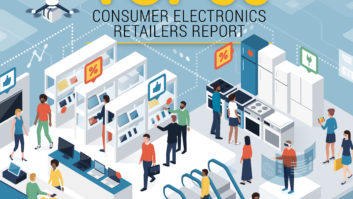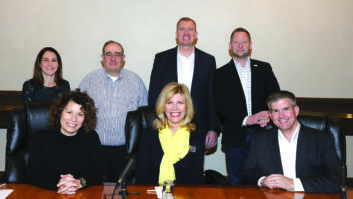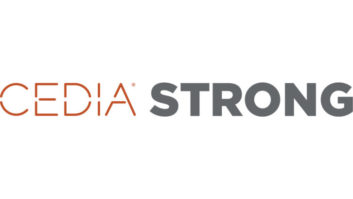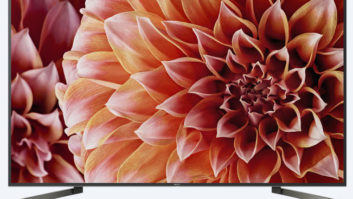Las Vegas – The hot holiday products that dominated the just-ended holiday selling season are set to remain the big sellers for 2005, according to the panelists at the annual TWICE Retail Roundtable, moderated by senior editor Alan Wolf.
Here are their thoughts on a variety of topics:
Display’s The Thing: Consumers Pounce On Flat Panel
TWICE: Falling prices on flat panel displays helped make them a holiday hit, but strained the supply channel. How did you meet demand?
Jim Ristow, Home Entertainment Source: Typically, the independent channel struggles to get allocation of product. Thanks to some of the new [warehousing] initiatives we made in the past year, we were fortunate to have sufficient microchip rear projection, and plasma was not an issue at all. Our forecasts were met.
While we had very good availability for the members overall, we did have some issues with LCD panels. Those issues were price compression, and with that the underestimation by the whole CE community of just how quickly consumers were willing to adapt and pay more to get this hot new technology. We thought that delta might need to be lower, but we all were wrong.
Ross Rubin, NPD Techworld:
On a lot of the flat panels, there’s a clear differentiation that consumers can readily understand. They don’t have to get caught up in the whole, “How do I get HD [high definition], refer me to my TV service provider” scenario. They’re drawn to that big screen experience on the low end. I think that’s why we’ve continued to see ED [enhanced definition] do very well even as the prices of the hi-def products are coming down a bit.
TWICE: Do you think consumers understand the difference between enhanced definition and high definition? Are many who jump at these lower priced panels in for a disappointment when they realize their sets can’t process a high definition signal?
Tony Weiss, CompUSA: Yes. There’s a whole customer education issue as to what the differences really are between ED and HD, and an understanding of what the limitations of an ED panel are today versus what consumers might want them to do in the future as more high definition content is out there.
While there may be some consumer disappointment, I don’t think you see it yet. It will happen down the road as more HD content is distributed and they try to utilize the product in the way in which they want and can’t. Today they’re excited about the product they got because it’s cool, sexy, nice looking, new, and something they really wanted. Tomorrow they may not get all the benefits that they hoped to derive from it when they bought it.
Judy Quye, Tweeter: I’d second that. I think people are buying flat panels for their aesthetics. It looks and feels cool, but they don’t really have the capability of understanding what the device will do.
Weiss: The product itself is really interesting. One of the things — when you look at new products and what helps drive sales during the holidays — is that the decision makers during holiday season sometimes change, relative to who makes the decision in the household, whether it’s the man, woman or a combination of both relative to those products.
The thin panel products that are out there obviously have other benefits within the house, when people look at decorating their homes. The customer can put them up and they’re not as intrusive. They’re sexy and cool and look nice in the house.
Rubin: Big spousal approval factor.
Douglas Moore,CircuitCity: I think what you sense is high excitement by all of us at the table about digital television. It’s all those things: flat and thin, 16×9, hi-def, digital. The consumer is getting an opportunity to buy more of all those things at a lower cost per inch than they did last year. I think they showed up over the holidays and voted with their pocketbooks.
How we sort our way through all those issues is going to be the fun part of the next couple years. Americans have to replace a couple hundred million televisions. Whether they come in at ED, HD, digital, flat and thin, sort of flat and sort of thin — they’re excited because it’s much better than what they’ve had. The days of the analog 52-inch big boulder with a screen in front of it are numbered. They’ll have sustaining power for the next couple of years, because there are certainly going to be value statements down there. But you can just sense the excitement of all of us about what’s going on in the market.
Audio Evolution Forces New Ways To Consider The Category
TWICE: Why hasn’t the excitement in flat panel TV carried over to component audio? Has the form factor not followed suit fast enough? Or has the iPod simply overshadowed the category?
Judy Quye, Tweeter: Certainly the iPod is at the forefront of audio right now. It’s an exciting new portable technology. But installing new technology in your home is also becoming an important part of the audio experience. Certainly at Tweeter, the audio piece that’s growing is the installation portion that goes with in-wall and distributed audio through your home. We’re seeing some exciting things happen in audio, but it’s mostly related to the home installation business.
Jim Ristow, Home Entertainment Source: We actually saw our component sales go up last year. With the price erosion beginning on flat panel display technology, we’re finding that our specialty A/V dealers are now able to attach audio. We’re starting to see audio come back fairly strong because the consumer is now able to devote more money to sound. I think we’re going to see that trend transition into the other channels very shortly also.
Tony Weiss, CompUSA: In many instances, purchases of flat panel televisions represent upgrades. But the consumer doesn’t perceive as much value in audio today to make a decision to upgrade those products as well. If you look at the new video technology, there’s a dramatic change in going from a tube or CRT projection TV to an LCD or plasma television in terms of what it offers in stylishness and other features.
In audio products, other than technologies like the iPod, there’s not a lot that’s tremendously different to offer a compelling reason for the consumer to upgrade, unless they’re more into their audio product than the traditional consumer who’s now only involved in flat panel television.
Ross Rubin, NPD Techworld: We talk about the iPod as the modern day Walkman, but the usage is quite different. The fact that you can put a significant percentage of your music collection on that device explains why a lot of the docking accessories have been doing so well. People are moving it from place to place, enjoying their music nomadically.
We are starting to see the same thing with satellite radio and will start to see it with DVD as well, as those products become easier to move into multiple environments. It’s a challenge how we categorize and track these things and how you guys merchandize them. The challenge is to make consumers increasingly aware of the versatility of what were previously thought of as mobile products. They’re starting to blur those categories.
Frank Sadowski, Amazon.com: That’s a good point. There’s little doubt that people are using their iPods as their music repository for their home system.
Amazon, incidentally, had a growth season in audio overall last quarter, and somewhat of a resurgence in traditional home audio sales.
I’m not sure I agree with Tony’s upgrade comment. Look at unit sales of home television, even subtracting small commodity CRT sets. Compare the unit sales of TVs 32 inches and higher, versus the total unit sales of anything in audio that could be reasonably called home theater, and the fact is that the vast majority of American households have decided not to attach audio to their video experience.
That to me, coming out of the audio business career-wise, has always been a huge mystery. I’ve never met anyone who’s sat in front of a quality audio system who would say, “That doesn’t sound a whole lot better.” Everyone says, “Wow, that sounds great.”
Assuming that people like the way it sounds and they want it, it leads me to the conclusion that the majority of people have decided that that’s not a good value for what we’re asking for that experience. When we see what is selling now in audio, the industry suppliers have been smart enough to develop good sounding low-priced home theater systems. If we look at NPD data, that’s what’s selling. The vast majority of customers may want to spend $3,000 for a big screen TV — that represents a value to them — but spending $1,200 to $1,500 to add on the audio experience is not a value and they won’t do it. But maybe they will at $299.
That’s O.K. We have to find out what the consumers want. For way too long, we’ve been saying, “You have to want this.” Guess what? They don’t have to want it. The data is there that the vast majority of people have said, “No thanks.”
Rubin: When they hear the audio output, they appreciate it, but are intimidated by the set-up. It goes back to some of those aesthetic issues we mentioned. We’re starting to see more manufacturers introduce wireless systems.
Sadowski: And flat speakers to go with flat TVs.
Doug Moore,CircuitCity: At Circuit City, we’re looking at the audio business in 2005 as an opportunity. Frank makes a lot of great points about what has happened in the first couple of years of new video technology. We don’t know the answer. We were rather quick to provide low-price home-theater-in-a-box. The industry has helped satisfy that need.
But there’s some real opportunity at a different place. If people are going to put $2,000 to $4,000 into essentially a video monitor, then source and sound — meaning how and where they get their content and how they listen to and watch it — is something we’re going to work on fixing. We’ve got 600 places to go through that with folks. We’re going to figure out how to do better in that area.
TWICE: Has the consumer responded to the better HTiBs?
Moore: It’s very situational to which store we’re talking about. It matters as to what we do as operators, in addition to merchants. We’ve got work to do in both those areas in audio and we intend to do more of each in how we buy and sell that product.
TWICE: Do you agree with Jim, that as flat panel prices continue to compress it will free up video dollars that consumers could now use to upgrade their audio systems?
Moore: I don’t know.
Quye: In retail, we have not been successful in showing the full solution experience, from the entry level point all the way up to the high-end home theater. Probably we’ve done better in the high-end theater rooms than we have in the entry-level experience. When you put the HD content together with a great sound experience and you have a nice, deliverable package for a customer in the $5,000 range with a flat panel display, they get very excited. The next question then becomes, “How do you bring them to life in my home?”
I don’t know that the consumers are not voting that that’s a value for them. It’s an education and understanding opportunity. It’s the industry’s opportunity to help the consumer understand how they get it in their home.
TWICE: How much of that responsibility is the retailer’s versus the vendor’s?
Quye: We work together. We have the consumer in our stores in front of the technology, so we have the window of opportunity from a relationship and demonstration perspective. The vendor community is what brings it to life.
Moore: They’re creating great product. Wireless enables a lot of technology there potentially. Miniaturization allows for things like flat and small speakers to really deliver. There’s tricking the system through software, which allows for some virtual surround sound. This is probably more of an operator opportunity than a vendor opportunity.
Rubin: In a lot of the home audio categories, we saw some slowdowns related to the saturation of the CD player. In home-theater-in-a-box, we’re starting to see some of that with the DVD as well, since that’s in so many households. Perhaps as we move to the high definition formats there’s a chance to revitalize some of the audio sales with integrated high-def units. That may be where the next wave of consumers upgrade their A/V equipment.
Quye: With the amount of digital music that’s being downloaded in the world, right now primarily into personal computers and iPods, and with the advent of the media center PC and digital hardware that would bring music into your home, we’re looking at a whole new beginning for the audio experience going forward.
Ristow: Exactly. The last few years we kept hearing, “Whoa, audio is dying.” The numbers keep going down, but in reality, is it really dying or has it changed? It’s changed. Now how quickly can the traditional suppliers and we as traditional merchants adapt to give the best possible experience to the consumer?
Moore: Somewhere between where audio was — the old mix-and-match sound room we all wandered in and out of in the last 20 years — and the current portable audio players, there’s an answer that we just haven’t come to yet. The great news about MP3 and iPods is that people are carrying music with them everywhere because they can. There’s something there that’s bigger than life. We need to work on it.
TWICE: Speaking of portable audio, what kind of opportunity does satellite and high definition radio offer?
Moore: It certainly was a bright spot during the fall season. As Judy mentioned, satellite radio was a massive win for anybody who had it. It sold everywhere — on our Web site, I’m sure on Frank’s, and in every one of the outlets represented here — as we sold almost as much as we could get our hands on. It was at all levels of consumer price points, and every one of those price points delivered what it promises: portable audio when I want it. Getting content out of thin air without a lot of effort is pretty neat. Satellite radio and the MP3 are related activities. So stay tuned; it’s going to be fun.
Rubin: We’re starting to see products that combine those two technologies. They’re very complementary: you can enjoy the library you already own and be exposed to new music you might enjoy.
TWICE: Yes. Suppliers can now XM-enable their devices for a buck a unit.
Rubin: The success of satellite radio as opposed to some of the other subscription-based products we’ve seen is that consumers understand, from satellite television and cable, the model of paying for selection and quality of content. It’s a straightforward value proposition for them.
TWICE: And is there also a market for iBiquity’s HD radio?
Rubin: Yes. Just like with satellite radio, the car manufacturers will play a huge roll in its adoption. It presents some opportunities for established broadcasters. We’ll see to what extent they take advantage of it. Right now, it’s going to be a slower ramp up curve because there’s no subscription and you can’t subsidize the hardware the way an XM or Sirius can. But there’s hope for the future of free radio, even without Howard Stern.
Youth Market Will Drive New Methods Of Content Management
TWICE: Do you agree that young people are driving demand for the media server as entertainment hub?
Ross Rubin, NPD Techworld: Yes, it’s generational. They have a huge comfort level with the PC. Also, increased penetration of broadband is helping it. It’s enabling some of these living room content opportunities that wouldn’t have been possible.
Don Carroll, RadioShack. It’s definitely generationally pushed. The youth are driving the change in the marketplace. We see parents bringing their kids in to help them pick out the technology. The kid goes home and installs it.
Tony Weiss, CompUSA: It’s a great new source of cheap labor.
Judy Quye, Tweeter: Young people are willing, with a bunch of devices, to participate with technology wherever it is.
TWICE: But is TV among them? Is it as important to them as it was to their parents?
Quye: I think youth is attracted to everything that’s going on with video, from the smaller form factor to the HD sports experience that you get from DLP. They’re the primary gamers of the world. If you’ve ever played a game on big screen technology, it doesn’t matter what age you are — it’s fun. I have no fear that the whole TV and video business is going to grow in every generation.
Rubin: The younger generations also have a love affair with television, but they think of it as more of a product open to multiple kinds of entertainment rather than the three channels that many Americans grew up with.
Carroll: We’ve done research, and this is well-known in the industry, but young people are multi-taskers. They’ll watch TV while surfing the Web while listening to their Apple iPod. They’re vast consumers of digital content. It’s going to depend on their reference point. What we’re talking about is where does the brain of the modern hub sit? In the den with the PC or in the living room on the TV?
Doug Moore,CircuitCity: Or is it everywhere?
Carroll: That’s the challenge for a lot of the OEMs: how do you get to be everywhere and make it easy? They’re going to be demanding customers, from a youth marketing standpoint. They’ve never not known a computer. Think about the people in this room. The fear of technology came from, “I bought a computer. Gee, if I press the right button, is it going to work?”
But young people will push any button on there without hesitating. The era of mass consumption from people who are no longer fearful of technology is upon us.
Rubin: The phenomenon of the changes in attitude towards experimentation is going to have a huge impact on manufacturers, who are used to designing stand-alone interfaces for isolated products. There’s nothing wrong with specialized products. They’re great and have a lot of strength in the marketplace, but the next generation is expecting consistency. That’s something manufacturers have to do a better job of.
Frank Sadowski, Amazon.com: I totally agree with all the generational comments. There are two applications that haven’t come together in the adult population in the United States. It’s the difference between entertainment products and productivity products, and the big crossover, without question, is music.
The reason for that is that music has become a personal experience instead of a group experience. I don’t want to date myself, but when a new album came out, all my friends used to sit down and listen to it a couple of times all the way through in a living room on a stereo.
Component audio is not a music product, it’s a video product. Music has become a personalized experience. Kids listen to it generally on their computer speakers, boom box, iPod or in their automobile, but not with their families or friends in the living room. If anything, that’s background music at this point.
Will it come to a point where content is not contained on shiny discs? Yes, because the new generation — the kids who have never not had a computer — is the first to accept that all this stuff is just files. They intrinsically understand it, whereas those of us who can remember when there weren’t computers have to get over it.
It was suggested that possibly the younger generation is watching less TV. The data shows that TV viewership is at an all-time high: more hours per week than ever before in history, and growing fast. Clearly, young people are not moving away from television. And unless they’re watching in a dorm room, most are not watching it on a computer. I believe it will happen, but there’s no strong evidence yet that people are willing to separate productivity products from entertainment products, with the exception of music, which again is a personal experience.
Entertainment networking will definitely start with music and move from there. But as retailers, we can really go into the weeds if we start trying to market products that there isn’t a need for yet.
Media Centers,Wi-Fi Revolutionizing Retail And Lifestyles
TWICE: Tweeter’s new prototype store in Las Vegas suggests that the company is betting on the media server as the heart and future of home entertainment.
Judy Quye, Tweeter: We’ve made a partnership with great brands, both HP and Microsoft. We have to provide the venue for the customer to vote on whether they want to use an open architecture or a more traditional architecture to bring digital media into their home. It’s not about making a bet; it’s about providing all the options and solutions.
As kids who’ve been breathing technology right out of diapers move into being purveyors and purchasers of the products we sell, we need to understand what they’re looking for. We look at it as a Petri dish opportunity to understand where the buying public is going to go with the possibilities. We’re excited about the partnerships.
TWICE: How does CompUSA foresee the future of distributed A/V?
Tony Weiss, CompUSA: Having a media hub is obviously very important to where things are going to go. Having all the different components and products associated with distributing the solution is one thing. The tricks to getting the consumer to adopt are ease of use and how you distribute and manage content. Neither of those things is easy today. That’s ultimately what will get that technology to become more mainstream in the consumer’s home: making the product easier for the consumer to use and finding more effective ways to distribute content — audio, pictures, video — across the home.
What we’re seeing today, at least in our business, is a significant number of consumers making purchasing decisions that are media center enabled, so they’re ready for the future. Only a percentage of them are taking advantage of all of the benefits that are there. A significant piece of our mix in both our assortment and our sales at CompUSA is made up of media center PCs, both on desktop computers as well as portable mobile laptop technologies.
We’re seeing two angles: the traditional home and the college dorm room. During back-to-school, we saw significant impact from media center technologies for the dorm room, where people could watch the television as well as distribute music and do it in a very compact form or fashion.
Don Carroll, Radio Shack: You’re seeing a lot of these things being driven generationally by say, 25- to 35-year-olds who have the disposable income and are not afraid of the technology. They’re adopting it early. They’re the ones leading the marketplace. I don’t think it’s a fourth-quarter trend that’s evolving. It’s a trend from two years ago that we’ll have for the next five to 10 years, this migration to digital technology.
Rubin: If you understand that the digital libraries are growing, you understand the need for some kind of interface to it. That’s one thing media center provides. It’s interesting to see so much of the music moving to the PC these days. Is it a coincidence that home audio component sales are going down? There’s some convergent competition there.
A lot of consumers don’t understand the notion that the music doesn’t have to physically reside where I’m enjoying it. That’s a conceptual shift that’s going to take quite a few years for people to understand.
Doug Moore,CircuitCity: Our point of view is that Americans have their highest love affair with the television. The PC, although it’s taking on aspects of being entertainment-driven, is still a device that they like a lot. The passion in the business is going to gravitate toward the living room and what happens there. You’ve seen it with the key global vendors who have shown up in the living room that weren’t there before.
Whatever opinion that we have about the business and where it’s going, the only thing I’m sure about is we’re probably wrong. I just don’t think we know. We have to continue to catch consumers where they are, put them in position to take advantage of whatever’s available at the moment, and keep moving that business just a few feet in front of where they want to be so they continue to move toward it.
I don’t know how each of us here will participate in that, but that’s our job. Products that you see at CES are often way out in front of the consumer. They generally have to be revised or put back to where the consumer is willing to pay for whatever it is.
The debate about where the action is is healthy. It may be biased by where your heritage is. Obviously, we started as an audio/video retailer. We have a bent towards that. We still believe that the TV and an American on the couch is the most obvious thing to think about when you think about what might happen here.
Quye: Tweeter believes that success will come from finding ways to untangle the consumer’s mind through the store experience so they can understand how to take these technologies into their homes and lives. Our new retail prototype is a combination of notional spaces where you see complete distributed entertainment solutions built on the partnerships we have with HP and Microsoft.
The center of the store is the design center, so that the consumer can look at building their electronics home or life as more than one component. I like to think about it like furnishing a home. You start with one room — the room you’re going to use the most — and put your investment there and build on it over time. Consumer electronics is very similar. We found that the whole design layout of your home, car, work, and life is important. Our goal in the store is to help people see how to put that together and show them some “wow” experiences, not only from home theater but in the living room, kitchen, bathroom, game room, kids’ room — you name it.
There’s less merchandise than you’re familiar with in a retail store because it’s more about education, understanding, and relationships. It’s a lab for us — a place for us to learn about the technology and the customer response so that we continue to run with the industry as it changes.
Jim Ristow, Home Entertainment Source: That’s what we’re talking about: the early adopter, the solution, the start-to-finish — not just the manufactured technology, but putting it into the consumer’s house and making sure they can understand and operate it.
As independent specialists, that’s basically what the roots of the Home Entertainment Source dealers are. We had dealers putting demo houses within their stores in the late 1980s and early 1990s, and offering distributed audio and these types of solutions. Now we’re seeing companies like Tweeter and some of the others who are on this panel, and some who aren’t, go into that whole category. Where this concept becomes mass market isn’t very far around the corner.
Rubin: It’s interesting to see how these demonstrations and the need to get it in front of the consumer has been driven by new entrants coming in from the PC side, with mixed degrees of success. You’ve had Apple doing it in its own stores. You’ve had Gateway trying it in its own stores and maybe now working with many of you here to do it in your stores. Dell with its kiosks, HP with Tweeter — I think all the PC guys, as they look to try to bridge that gap between productivity and entertainment, understand that there’s a lot of education to do.
Sadowski: I think the bridge truly is wireless technology. There’s always going to be a robust business in installation. That will continue to be an addressable minority of the households. But the American family and entertainment products purchaser has been spoiled with products that are easy to set up and use. Where businesses like add-on audio — a perfect example — have not been successful is where they’re very complex, with spaghetti factories of wires behind them that nobody even wants to understand. Wireless technology is a fundamental bridge to losing all of that and taking whole-house control systems out of the realm of the custom installer and the multi-thousand dollar installation and into the realm of the $99 wireless router. We’re not there yet. It doesn’t work that well yet and people don’t understand it, but it will work really well and simply very soon. People will understand how to do it because people are putting wireless networks by the millions out there in their homes. That will be the bridge.
The last point is that the software for control systems that had cost thousands of dollars and required hundreds of hours of custom programming is changing rapidly. There are new core control software technologies out there by some very aggressive start-up companies, one of which Tweeter is working with. They’re going to change the control side of it.
The control software coming way down in price and complexity and the wireless connection will be the bridges to mass acceptance of this. I believe that it’s on the verge of mass acceptance in a very small number of years.
TWICE: That will further lower the barrier for entry to any guy working out of his trunk. Won’t that be disruptive to CEDIA-type installers and integrators?
Sadowski: Traditional installations are not coming down a lot in price. That customer’s always going to be there. There’s always going to be the customer that wants the media room and sophisticated control functionality. The core software is going to bring the price of the control functionality down, but the home installation business is going to be very healthy. It will never become a total mainstream product. I’m talking about what will be very good for the traditional retailer, in that people can pick up a box that is a solution: wireless, doesn’t require installation, and will do a lot.
Carroll: That’s what will reach the mass market: plug and play, in a box, and you pick it up and walk out. That may be the death of the independent installer, but I think we have other retailers that have a reputation for professional quality installation. If someone’s going to spend $4,000 to $5,000 on a home entertainment system, they’re going to want it done right.
Quye: I see the ease-of-use boxes that you can plug in, but when you put those all together in your room even today, you have six remotes on the coffee table. There’s do-it-yourselfers, and there’s do-it-for-me’s. There’s plenty of do-it-for-me’s out there and a lot of do-it-yourselfers who get started and then say, “Forget it. Come on in and do it for me. Give me the ease of use of a single remote and show me what that can look like in my life and my home.”
Ristow: You’ll see commoditization in installation, but for the early adopters, whatever the newest, latest, greatest is will need more than the mass-market solution. We see huge growth for our channel. We think we’re at the tip of some huge technology changes and adoption by our type of customer. It’ll help everybody at this table as it goes down in price.













